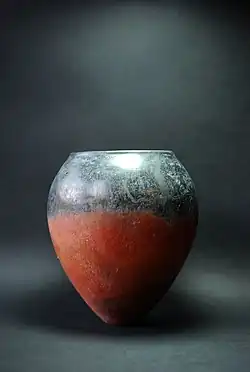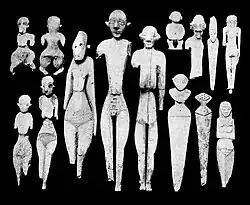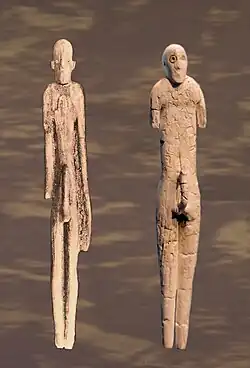Amratian culture
 el-Amra | |
| Dates | circa 4000 BC — circa 3600 BC.[2] |
|---|---|
| Major sites | El-Amrah, Egypt |
| Preceded by | Tasian culture, Badari culture, Merimde culture |
| Followed by | Naqada II (Gerzeh culture) |
The Amratian culture, also called Naqada I, was an archaeological culture of prehistoric Egypt, centering on Upper Egypt. It lasted approximately from 4000 to 3500 BC[3] (Petrie Sequence Dates: SD 31–37).[4]
Overview
The Amratian culture is named after the archaeological site of el-Amrah, located around 120 km (75 mi) south of Badari in Upper Egypt. El-Amrah was the first site where this culture group was found without being mingled with the later Gerzeh culture (Naqada II). However, this period is better attested at the Nagada site, thus it also is referred to as the Naqada I culture.[5] Black-topped pottery continued to be produced, but white cross-line pottery, a type which has been decorated with close parallel white lines being crossed by another set of close parallel white lines, begins to be produced during this time. The Amratian falls between S.D. 30 and 39 in Flinders Petrie's sequence dating system.[6][7]
Trade between the Amratian culture bearers in Upper Egypt and populations of Lower Egypt is attested during this time through new excavated objects. A stone vase from the north has been found at el-Amrah. The predecessor Badarian culture had also discovered that malachite could be heated into copper beads;[a] the Amratians shaped this metal by chipping.[8] Obsidian and a very small amount of gold were both imported from Nubia during this time.[5][6] Trade with the oases also was likely.[5] Cedar was imported from Byblos, marble from Paros, as well as emery from Naxos.[8]
New innovations such as adobe buildings, for which the Gerzeh culture is well known, also begin to appear during this time, attesting to cultural continuity. However, they did not reach nearly the widespread use that they were known for in later times.[9] Additionally, oval and theriomorphic cosmetic palettes appear to be used in this period. However, the workmanship was still very rudimentary and the relief artwork for which they were later known is not yet present.[10]
Each Amratian village had an animal deity; amulets were worn of humans and various animals including birds and fish. Food, weaponry, statuettes, decorations, malachite, and occasionally dogs were buried with the deceased.[8]
-
 Ovoid Naqada I (Amratian) black-topped terracotta vase, c. 3800–3500 BC
Ovoid Naqada I (Amratian) black-topped terracotta vase, c. 3800–3500 BC -
Clay model of four head of cattle, c. 3500 BC, found at El-Amrah
-
_(3802228234).jpg) Clay figure, Egypt Naqada I period, circa 4000 BC. RMO Leiden
Clay figure, Egypt Naqada I period, circa 4000 BC. RMO Leiden -
![Egyptian disk-shaped macehead, 4000–3400 BCE. At the end of the period, it was replaced by the superior Mesopotamian-style pear-shaped macehead, as seen on the Narmer Palette.[11]](./_assets_/Egyptian_disk_macehead_4000-3400_BCE.jpg) Egyptian disk-shaped macehead, 4000–3400 BCE. At the end of the period, it was replaced by the superior Mesopotamian-style pear-shaped macehead, as seen on the Narmer Palette.[11]
Egyptian disk-shaped macehead, 4000–3400 BCE. At the end of the period, it was replaced by the superior Mesopotamian-style pear-shaped macehead, as seen on the Narmer Palette.[11] -
 Naqada I, Amratian statuettes
Naqada I, Amratian statuettes -
![Death mask. Naqada Ic–IIa (3750 BC). Hierakonpolis elite cemetery (HK6, Tomb 16).[12][13]](./_assets_/Hierakonpolis_death_mask_(elite_cemetery)._Nagada_Ic_%E2%80%93_Nagada_IIa_(3750_BC)._Upper_Egypt%252C_Hierakonpolis_(HK6%252C_Tomb_16)._Egyptian_Museum%252C_Cairo.jpg)
Early cosmetic palettes
Siltstone was first utilized for cosmetic palettes by the Badari culture. The first palettes used in the Badarian Period and in Naqada I were usually plain, rhomboidal or rectangular in shape, without any further decoration. It is in the Naqada II period in which the zoomorphic palette is most common.
-
._Predynastic%252C_Naqada_I._4000-3600_BC._EA_37913_(British_Museum).jpg) Mudstone cosmetic palette in the form of a turtle with inlaid bone eyes (one missing). Predynastic, Naqada I. 4000–3600 BC. EA 37913 (British Museum)
Mudstone cosmetic palette in the form of a turtle with inlaid bone eyes (one missing). Predynastic, Naqada I. 4000–3600 BC. EA 37913 (British Museum) -
.jpg) Mudstone palette in the form of a hippopotamus. Predynastic, Naqada I. 4000–3600 BC. EA 29416. (British Museum)
Mudstone palette in the form of a hippopotamus. Predynastic, Naqada I. 4000–3600 BC. EA 29416. (British Museum) -
 Naqada I–II palette for blending cosmetics
Naqada I–II palette for blending cosmetics -
 Palette in the shape of a boat, 3700–3600 BC, Naqada I
Palette in the shape of a boat, 3700–3600 BC, Naqada I
Penile sheaths
Numerous male statuettes from the Naqada I-III period are shown displaying penile sheaths, a characteristic attribute of many hunter-gatherer societies.[16] Such depictions appear in Hierakonpolis, Abydos, on the Gebel el-Arak Knife, or on the golden statuettes of Tell el-Farkha.[16] They were held in place by leather strings tied at the waist, and possible at the bottom as well.[16]
It has been suggested that many of the decorated rhinoceros tusks also found in tombs of the period may be the very penile sheaths depicted in these statuettes, or at least symbolic representations of them.[16][17] Penile sheath (karnatiw) may also have been used for medical reasons, in a mistaken attempt to avoid schistosomiasis and contamination by cercariae.[18]
Other artifacts
-
 Naqada I pottery
Naqada I pottery -
 Lower-Egypt basalt jars in the shape of pottery from Maadi, Naqada I–II, British Museum EA 34398, EA 26654
Lower-Egypt basalt jars in the shape of pottery from Maadi, Naqada I–II, British Museum EA 34398, EA 26654 -
.jpg) Vase, Amratian, Naqada I
Vase, Amratian, Naqada I
Relative chronology
See also
Archaeological reports
- Petrie, W. M. Flinders (William Matthew Flinders); Quibell, James Edward (1896). Naqada and Ballas. 1895. London, B. Quaritch.
References
Footnotes
- ^ Copper may have also been imported from the Sinai Peninsula or perhaps Nubia.
Citations
- ^ "Figurine". Louvre Museum. 2025.
- ^ Hendrickx, Stan. The relative chronology of the Naqada culture: Problems and possibilities [in:] Spencer, A.J. (ed.), Aspects of Early Egypt. London: British Museum Press, 1996: 36-69. p. 64.
- ^ Shaw, Ian, ed. (2000). The Oxford History of Ancient Egypt. Oxford University Press. p. 479. ISBN 0-19-815034-2.
- ^ "Naqada chronology". www.ucl.ac.uk. University College, London.
- ^ a b c Grimal, Nicolas (1992). A History of Ancient Egypt. Blackwell. p. 28. ISBN 0-631-17472-9.
- ^ a b Gardiner, Alan (1964). Egypt of the Pharaohs. Oxford: University Press. p. 390.
- ^ Newell, G.D. (2012). The relative chronology of PNC I. A new chronological synthesis for the Egyptian Predynastic. ex.cathedra Press.
- ^ a b c Smith, Homer W. (2015) [1952]. Man and His Gods. Lulu Press. pp. 16–17. ISBN 9781329584952.
- ^ Redford, Donald B. (1992). Egypt, Canaan, and Israel in Ancient Times. Princeton: University Press. p. 7. ISBN 0-691-03606-3.
- ^ Gardiner, Alan (1964). Egypt of the Pharaohs. Oxford: University Press. p. 393.
- ^ Isler, Martin (2001). Sticks, Stones, and Shadows: Building the Egyptian Pyramids. University of Oklahoma Press. p. 42. ISBN 978-0-8061-3342-3.
- ^ Tamás, Bács (2017). Bevezetés az ókori Egyiptom művészetébe (PDF). Budapest: Gondolat Kiadó. p. 13, Fig.2. ISBN 978 963 693 791 1.
- ^ Friedman, Renee (1 January 2011). The elite Predynastic cemetery at Hierakonpolis: 2009–2010 update. Orientala Lovaniensia Analecta. pp. 157–192.
- ^ Tamás, Bács (2017). Bevezetés az ókori Egyiptom művészetébe (PDF). Budapest: Gondolat Kiadó. p. 16, Fig.6. ISBN 978 963 693 791 1.
- ^ Ciałowicz, Krzysztof M. (2012). "Votive figurines from Tell el-Farkha and their counterparts". Archéo-Nil. 22 (1): 88–90. doi:10.3406/arnil.2012.1044.
- ^ a b c d Orriols i Llonch, Marc (2020). "Predynastic tusks and penis sheaths: a new interpretation". Archéo-Nil: 149–167.
- ^ Hendrickx, S.; Eyckerman, M. (2008). "Tusks and tags. Between the hippopotamus and the Naqada plant". Egypt at its Origins 3. Proceedings of the International Conference “Origin of the State. Predynastic and Early Dynastic Egypt”. Leuven. pp. 497–570. ISBN 9789042924901.
- ^ Nunn, John F. (2002). Ancient Egyptian Medicine. University of Oklahoma Press. p. 69. ISBN 9780806135045.


.jpg)